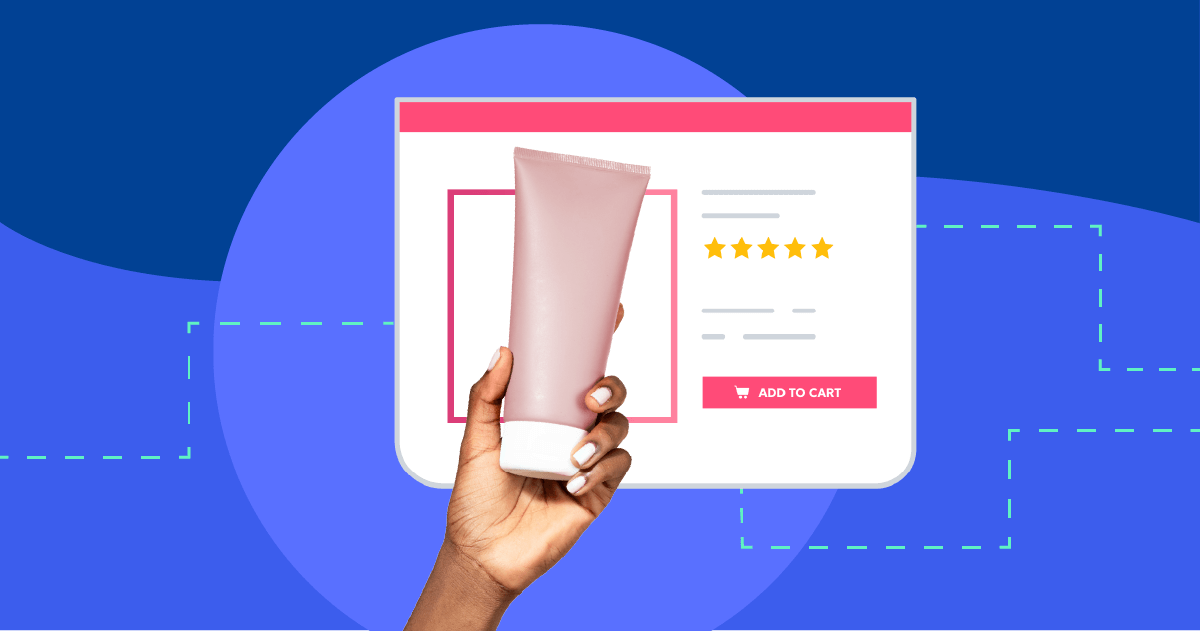May 7, 2024
There were over 2.5 billion online shoppers last year and that number is only going to grow. Your product pages are an integral part of that buying journey for these shoppers, but according to Baynard Institute research, only 56% of e-commerce sites have an overall “decent” or “good” product page performance. While that might sound some alarm bells, it’s nothing a little product page optimization can’t fix.
Optimizing your entire digital shelf — your virtual store where people find and buy your brand online — is essential for providing customers with a great shopping experience. It’s how your brand shows up online, stands out from competitors, and encourages shoppers to make purchases.
Chapters:
- What is product page optimization?
- 5-point product page optimization audit
- Product page optimization examples
- Take your product pages to the next level
What is product page optimization?
Product page optimization is the process of improving all aspects of your product pages so potential customers can find exactly what they’re looking for and make informed purchasing decisions. It goes way beyond just inserting keywords and some witty copy, it’s about displaying authentic imagery, writing compelling descriptions, and using the voice of the customer.
In essence, product page optimization is about enhancing the entire user experience to make the buying process as seamless as possible.
An optimized product page is a page that first and foremost meets customer needs and achieves company goals. Traditionally, this refers to a product page designed for higher conversions and/or search engine optimization (SEO). You also need to factor in the technical side too. Page load speed for example — nearly 70% of consumers admit that page speed impacts their willingness to buy from an online retailer.
Think about the last time you bought something online. What did you need to know from the product page in order to make it all the way through to check out? Just the specs? No. You probably needed a lot of different information to make a confident purchasing decision. Most customers want to know:
- Is this product good quality or value?
- How does this product look in real life?
- What do other people think about this product?
- Is there anything else I need to buy to make this product work?
- How are other shoppers using this product?
And with only 2% of e-commerce website visits converting into a purchase, it’s clear that online merchants can do a better job of providing information and experiences that meet shopper needs.
5-point product page optimization audit
During the recent iteration of the Bazaarvoice Summit, Brandon Klein, Senior Product Manager at Bazaarvoice (and expert on all things product page), outlined a 5-point audit for perfecting your product pages. Here’s what he recommends.
1. Product page SEO optimization
You’ve spent a lot of company time and resources optimizing your product pages for higher conversions. But that’s all for nothing if shoppers can’t actually find your product pages through search — that’s where product page SEO comes in. Brandon highlights this point in this short clip from his Summit presentation below:
Expanding on that, product page SEO is the optimization of your product pages so the content on the page is found by search engines like Google. Search engine algorithms prioritize pages that are most relevant to the search query based on criteria like keyword matches and quality content.
Here’s some of our favorite ways to use keywords naturally:
- Include keywords in your page’s title tag and meta description, and make sure the page’s actual copy matches what you promise
- Use headings to break up copy and organize your page. Try to include a keyword in at least one of the headings, but only if it makes sense
- Include keywords throughout the page, like in product names, descriptions, and reviews
- Incorporate keywords into an image’s alt-text if it naturally flows with the rest of the alt-text copy
- Add internal links to any other related content on your site
The easiest way to boost your SEO though is by featuring user-generated content (UGC) like customer reviews, which can increase page traffic by nearly a third.
Customers writing reviews typically use long-tail keywords. So when someone else searches for the same terms found in product reviews, product pages linked with them appear in search results. Petco for example utilized UGC to boost their SEO standings and guess what happened? They saw a:
- 67% increase in number of pages ranked organically
- 140% increase in impressions from organic search
- 80% increase in clicks from organic search
In total, this led to a 48% increase in revenue per visit.
Product page SEO optimization isn’t just about ranking higher on Google and getting more site visits. The main goal here is to create a better user experience and give customers the exact information and visuals they need to make a confident purchase.
2. Put UGC front and center
We know UGC is great for product page SEO. But it’s also what shoppers want to see when they’re browsing your digital (and physical) touchpoints. According to our recent survey, 74% of shoppers say they trust UGC more than branded content on product pages, and 55% are unlikely to buy a product without shopper content to inform their purchasing decisions.
UGC works because it provides the social proof shoppers need to inform decisions. According to Sabine Kaufmann, Head of e-commerce Operations Dining & Lifestyle, Villeroy & Boch, “user-generated content is one of the most trustworthy types of content a brand could show to their customers.”
Best Buy does a great job of displaying star ratings and review counts at the top of its product pages to help customers make confident purchasing decisions. On this listing for an iPad, shoppers will see that more than 3,400 customers have reviewed the product, and it has an average rating of 4.8 stars.
Seeing an overall positive customer sentiment right away takes some of the risks out of buying an expensive item.
When it comes to collecting this UGC, diversifying your efforts is key because you’ll need a lot. You should consider leveraging review request emails and text messages, social media sweepstakes, and community requests. The most effective method for collecting UGC is product sampling, where you provide product samples in exchange for honest reviews or images. We surveyed 6,000 sampling recipients, and of those:
- 63% purchased the product they sampled
- 97% purchased at least one additional product from the brand
But according to Brandon, your best bet is using a range of solutions. These different strategies can kick-start your collection efforts, ensuring a constant supply of UGC across various methods simultaneously.
3. Respond to negative reviews and proactively address product shortfalls
Customers don’t mind if you have a few negative reviews for a product. They actually prefer it. We’ve seen that products with one or more negative reviews are perceived as more authentic and have higher conversion rates than those with a perfect 5-star rating or zero negative reviews.
People also like responses to their negative reviews too — 54% of shoppers expect a response from the company if they write a negative review. The most successful e-commerce retailers use negative reviews as an opportunity to engage with customers, and identify potential product page improvements. The latter part is something Brandon called out specially in his presentation.
Negative reviews provide insights for improving products, which you can then update your product pages with. For example, several shoppers may leave a review saying that a pair of pants they ordered in their normal size ended up being too big. This negative feedback would allow your brand to update that product’s description to include helpful language like, “for a perfect fit, many customers prefer to size down.”
Children’s toy manufacturer KidKraft are pros at this. Watch Heather Stables, KidKraft’s Director of Consumer Engagement, explain how they use customer feedback to improve products and market messaging:
After recognising insights, the brand works on product page optimization to ensure copy matches the new product updates. They’ve since seen product improvement leading to an increase in sales.
Not only does utilizing customer feedback help consumers feel empowered to make better purchase decisions, but it can also prevent future negative reviews related to product description accuracy.
4. Distribute your content everywhere
Shoppers want a seamless transition as they engage with your brand through multiple channels, whether online, mobile, or in-store. 75% of shoppers expect a consistent brand experience regardless of channel, according to our Shopper Experience Index. Taking an omnichannel approach integrates your various channels to provide a consistent brand experience, letting you interact in the most convenient way.
Not having a robust omnichannel strategy is now a key barrier to success
Ainslie Fincham, Marketing Director, Urban Barn
An omnichannel strategy allows for quick adaptation to changing consumer preferences. It lets customers switch between channels without friction or loss of service, improving customer satisfaction and fosters loyalty.
Once you have this valuable content, it’s crucial to showcase it in all the right places — on social, in ads, on your product pages, and even in-store. You can do this by working with the right content syndication partner. By syndicating your content across all digital touchpoints, you ensure that customers can see it wherever they shop, maximizing your content ROI.
5. Make social content shoppable
Lastly, but certainly not least. Making your social content shoppable is by far one of the most important ways to increase your product page optimization. Social media is often the first place most shoppers will discover your brand, with 54% of consumers saying they often discover a product or service through social media. (That number rises to 73% for 18-24 year olds!)
They aren’t just scrolling past your products either, they’re making purchases. While the younger generations are leading this charge, even a quarter of shoppers aged 65+ purchased through social last year.
50% of all shoppers have purchased products through social media in the past year. So make sure that you’re turning social content into shoppable experiences that drive sales wherever your shoppers are.
Shoppable content tools such as Like2buy turn your Instagram and TikTok Feeds into sales channels and Bazaarvoice Galleries brings authentic visual content from social into your website for you. For example Dreams, the UK’s leading bed specialist, uses Bazaarvoice Galleries to bring social UGC into its product pages and beyond, and has since seen a 200% lift in conversion rate.
Social is a great way to curate fresh, original, and authentic content that already exists, and has been created for you. But a recurring point Brandon makes around product page optimization is that channels shouldn’t be siloed. Put your social content across all channels and encourage purchase decisions everywhere your shoppers are.
4 product page optimization examples
Let’s take a look at some of our favorite examples of product pages that convert. Note: Your product descriptions need to be easy to digest, especially because most customers are shopping from their mobile devices. By 2025, mobile e-commerce sales will account for 44% of retail e-commerce sales in the U.S.
Iconic London
When it comes to makeup, authenticity reigns supreme. Shoppers want to see how different shades look on people who look like them, not in heavily curated brand imagery. Iconic London knows this and so brings in carousels of visual UGC from their community right onto their product pages.
Why it works:
- The average star rating and number of reviews at the top of the page provides proof that this is a well-loved product
- Large imagery puts more social proof front and center
- Authentic visual UGC from real customers using the product(s) at home helps shoppers understand what the product is and how it fits into their existing skincare routine
Neutrogena
Cosmetics is a product category that really requires detailed product pages because customers can’t see or swatch the item in person. On this product page for Neutrogena’s MoistureSmooth Color Stick, the company takes a UGC-first, product-second approach.
Why it works:
- A prominent design element halfway down the page includes a star rating and a quote from a customer about how the product feels in real life and how it works for their skin texture
- The gallery of social media images from real customers provides more information about how the product works in action
- The gallery encourages customers to “Share Your Glow” by tagging Neutrogena on Instagram or Twitter to be featured on the website
- The “Most Helpful Reviews” callout highlights one positive and one negative review that other shoppers have found useful
Nourison
Buying an area rug online can be a challenge because it’s difficult for shoppers to understand how it will look and feel when it arrives. Rug brand Nourison helps ease customers’ minds by incorporating a lot of great UGC on its pages.
Why it works:
- A gallery of social photos shows how customers have used this rug in their actual homes
- The brand encourages future customers to share how they styled their rug at home by posting a picture on social media with the hashtag #Nourison
- The page displays the average rating for the product and number of reviews at the very top to signal that hundreds of others have bought and loved this rug
- The company uses short but detailed product descriptions and includes specs that tell customers where this rug would be best in their homes (a heavy-traffic area vs. a less-trafficked area)
Under Armour
Our last example is a product page for an Under Amour shoe. The brand uses several tactics to help shoppers choose from the hundreds of shoes on its site.
Why it works:
- Shoppers get a complete, 360-degree view of the shoe, so they know there won’t be any surprises when they receive the product
- Shoppers can filter reviews by rating, athlete type (casual or avid), size, and locale to see reviews that are more personalized to how they may be using the shoe
- When a shopper starts to scroll on the page, the “Add to Bag” CTA becomes a sticky banner so customers can quickly put the item in their cart once they’ve made a decision
Take your product pages to the next level
Product page optimization may seem like a tedious task, but in the end, it will be well worth it. If shoppers have all the information they need to make a successful purchase, you’ll set yourself apart from your competitors and see much higher conversion rates across your digital shelf.
With the rise of digital, product page optimization has become critical for consumer attention and conversion. Watch our full on-demand masterclass outlining the 5-point audit for optimizing your product pages, covering key topics like organic search, social commerce, user-generated content, and insights.








